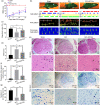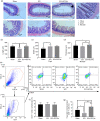Short-chain fatty acids ameliorate spinal cord injury recovery by regulating the balance of regulatory T cells and effector IL-17+ γδ T cells
- PMID: 37056207
- PMCID: PMC10106403
- DOI: 10.1631/jzus.B2200417
Short-chain fatty acids ameliorate spinal cord injury recovery by regulating the balance of regulatory T cells and effector IL-17+ γδ T cells
Abstract
Spinal cord injury (SCI) causes motor, sensory, and autonomic dysfunctions. The gut microbiome has an important role in SCI, while short-chain fatty acids (SCFAs) are one of the main bioactive mediators of microbiota. In the present study, we explored the effects of oral administration of exogenous SCFAs on the recovery of locomotor function and tissue repair in SCI. Allen's method was utilized to establish an SCI model in Sprague-Dawley (SD) rats. The animals received water containing a mixture of 150 mmol/L SCFAs after SCI. After 21 d of treatment, the Basso, Beattie, and Bresnahan (BBB) score increased, the regularity index improved, and the base of support (BOS) value declined. Spinal cord tissue inflammatory infiltration was alleviated, the spinal cord necrosis cavity was reduced, and the numbers of motor neurons and Nissl bodies were elevated. Enzyme-linked immunosorbent assay (ELISA), real-time quantitative polymerase chain reaction (qPCR), and immunohistochemistry assay revealed that the expression of interleukin (IL)-10 increased and that of IL-17 decreased in the spinal cord. SCFAs promoted gut homeostasis, induced intestinal T cells to shift toward an anti-inflammatory phenotype, and promoted regulatory T (Treg) cells to secrete IL-10, affecting Treg cells and IL-17+ γδ T cells in the spinal cord. Furthermore, we observed that Treg cells migrated from the gut to the spinal cord region after SCI. The above findings confirm that SCFAs can regulate Treg cells in the gut and affect the balance of Treg and IL-17+ γδ T cells in the spinal cord, which inhibits the inflammatory response and promotes the motor function in SCI rats. Our findings suggest that there is a relationship among gut, spinal cord, and immune cells, and the "gut-spinal cord-immune" axis may be one of the mechanisms regulating neural repair after SCI.
脊髓损伤可以引起运动、感觉和自主神经功能障碍。肠道微生物组在脊髓损伤中具有重要作用,而短链脂肪酸是微生物群的主要生物活性介质之一。在本研究中,我们探讨了口服外源性短链脂肪酸对脊髓损伤运动功能恢复和组织修复的影响。采用Allen方法建立SD大鼠脊髓损伤模型。脊髓损伤后,动物接受含有150 mmol/L短链脂肪酸混合物的水。治疗21天后,BBB评分升高,步态的规律性指数改善,后肢步宽值下降。脊髓组织炎症浸润减轻,脊髓坏死腔减少,运动神经元和尼氏体数量升高。酶联免疫吸附测定(ELISA)、实时定量聚合酶链反应(qPCR)和免疫组化检测显示脊髓中白细胞介素-10(IL-10)表达升高,IL-17表达降低。短链脂肪酸能促进肠道稳态,诱导肠道T细胞转向抗炎表型,促进调节性T细胞(Treg)分泌IL-10,影响脊髓中的Treg细胞和IL-17+ γδ T细胞。此外,我们观察到脊髓损伤后Treg细胞从肠道迁移到脊髓区域。以上结果证实,短链脂肪酸可调节肠道中的Treg细胞,影响脊髓中Treg和IL-17+ γδ T细胞的平衡,抑制炎症反应,促进脊髓损伤大鼠的运动功能。我们的研究结果表明,肠道、脊髓和免疫细胞之间存在一定的关系,“肠道-脊髓-免疫”轴可能是脊髓损伤后神经修复的调节机制之一。.
脊髓损伤可以引起运动、感觉和自主神经功能障碍。肠道微生物组在脊髓损伤中具有重要作用,而短链脂肪酸是微生物群的主要生物活性介质之一。在本研究中,我们探讨了口服外源性短链脂肪酸对脊髓损伤运动功能恢复和组织修复的影响。采用Allen方法建立SD大鼠脊髓损伤模型。脊髓损伤后,动物接受含有150 mmol/L短链脂肪酸混合物的水。治疗21天后,BBB评分升高,步态的规律性指数改善,后肢步宽值下降。脊髓组织炎症浸润减轻,脊髓坏死腔减少,运动神经元和尼氏体数量升高。酶联免疫吸附测定(ELISA)、实时定量聚合酶链反应(qPCR)和免疫组化检测显示脊髓中白细胞介素-10(IL-10)表达升高,IL-17表达降低。短链脂肪酸能促进肠道稳态,诱导肠道T细胞转向抗炎表型,促进调节性T细胞(Treg)分泌IL-10,影响脊髓中的Treg细胞和IL-17 + γδ T细胞。此外,我们观察到脊髓损伤后Treg细胞从肠道迁移到脊髓区域。以上结果证实,短链脂肪酸可调节肠道中的Treg细胞,影响脊髓中Treg和IL-17 + γδ T细胞的平衡,抑制炎症反应,促进脊髓损伤大鼠的运动功能。我们的研究结果表明,肠道、脊髓和免疫细胞之间存在一定的关系,“肠道-脊髓-免疫”轴可能是脊髓损伤后神经修复的调节机制之一。
Keywords: IL-17+ γδ T cells; Inflammation; Motor function recovery; Neuroprotection; Regulatory T cells; Short-chain fatty acids (SCFAs); Spinal cord injury (SCI).
Figures






Similar articles
-
Geniposide exerts protective effects on spinal cord injury in rats by inhibiting the IKKs/NF-κB signaling pathway.Int Immunopharmacol. 2021 Nov;100:108158. doi: 10.1016/j.intimp.2021.108158. Epub 2021 Sep 20. Int Immunopharmacol. 2021. PMID: 34555642
-
Local Delivery of β-Elemene Improves Locomotor Functional Recovery by Alleviating Endoplasmic Reticulum Stress and Reducing Neuronal Apoptosis in Rats with Spinal Cord Injury.Cell Physiol Biochem. 2018;49(2):595-609. doi: 10.1159/000492996. Epub 2018 Aug 30. Cell Physiol Biochem. 2018. PMID: 30165357
-
Recruitment of γδ T cells to the lesion via the CCL2/CCR2 signaling after spinal cord injury.J Neuroinflammation. 2021 Mar 2;18(1):64. doi: 10.1186/s12974-021-02115-0. J Neuroinflammation. 2021. PMID: 33653377 Free PMC article.
-
Changes of potential shorty-chain fatty acids producing bacteria in the gut of patients with spinal cord injury: a systematic review and meta-analysis.Front Microbiol. 2025 Feb 27;16:1483794. doi: 10.3389/fmicb.2025.1483794. eCollection 2025. Front Microbiol. 2025. PMID: 40083777 Free PMC article.
-
Targeted microbiota dysbiosis repair: An important approach to health management after spinal cord injury.Ageing Res Rev. 2025 Feb;104:102648. doi: 10.1016/j.arr.2024.102648. Epub 2024 Dec 25. Ageing Res Rev. 2025. PMID: 39725357 Review.
Cited by
-
Impact of inflammation and Treg cell regulation on neuropathic pain in spinal cord injury: mechanisms and therapeutic prospects.Front Immunol. 2024 Jan 29;15:1334828. doi: 10.3389/fimmu.2024.1334828. eCollection 2024. Front Immunol. 2024. PMID: 38348031 Free PMC article. Review.
-
A preliminary study on the changes of fecal short chain fatty acids in patients with traumatic spinal cord injury in the chronic phase.Spinal Cord Ser Cases. 2025 Feb 25;11(1):3. doi: 10.1038/s41394-025-00698-x. Spinal Cord Ser Cases. 2025. PMID: 40000601
-
The Role of Dietary Fibre in Enteral Nutrition in Sepsis Prevention and Therapy: A Narrative Review.Nutrients. 2023 May 26;15(11):2489. doi: 10.3390/nu15112489. Nutrients. 2023. PMID: 37299452 Free PMC article. Review.
-
Spinal cord injury: pathophysiology, possible treatments and the role of the gut microbiota.Front Microbiol. 2024 Dec 18;15:1490855. doi: 10.3389/fmicb.2024.1490855. eCollection 2024. Front Microbiol. 2024. PMID: 39744391 Free PMC article. Review.
References
-
- Allen AR, 1911. Surgery of experimental lesion of spinal cord equivalent to crush injury of fracture dislocation of spinal column: a preliminary report. JAMA, LVII( 11): 878- 880. 10.1001/jama.1911.04260090100008 - DOI
MeSH terms
Substances
Grants and funding
LinkOut - more resources
Full Text Sources
Medical

